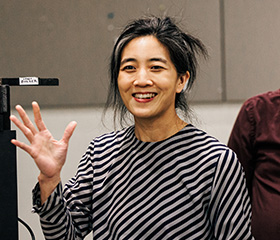One of the many things I appreciated about LCT’s current production of Uncle Vanya is the insight it gave me into Chekhov’s stature as a visionary of the modern. This perception became especially acute in the third of the play’s four acts, flashing with special brightness as I studied the furnishings.
So I knew one of the primary topics I wanted to take up with Mimi Lien, the set designer, was how that modern and contemporary look came about. “When the creative team was having early discussions,” Lien told me, “we agreed that we wanted to do this play in part because it still speaks to us now. We didn’t want the production to have the strict feel of a particular period. At the same time, Chekhov wrote the play in Russia in the late 19th-century and we didn’t want to disregard that completely.”
This philosophy affected Lien’s creative process. “I pored through old photo books at the New York Public Library,” she said. “I found an image taken by a Russian photographer in the 1920s. It was just called Wind and shows trees, slightly spaced apart.” Very much enlarged, the image sits at the rear of the Beaumont stage. “It feels like an artifact,” Lien said. “I wanted to treat the image as a photograph as opposed to a theatrical backdrop.”
Before the image ended up on the stage, Lien, who has worked for LCT in its Newhouse and Tow spaces, put it in her design’s model box. “My process is always very model-based – that’s where I try out my ideas initially.” One of the other things she put in the model was a piece of wood veneer. “It had a grain that made me think of rivers on a topographic map, which felt appropriate because Astrov talks a lot about his maps.”
Once Lien perfects her model she must turn to another crucial piece in her process: translating the mini version to the realities of the stage. “That was a big challenge with this production,” she said. “The material we used needed to adapt to the large downstage space of the Beaumont, and you can’t have one giant piece of wood that’s seamless.” Lien added, “One way that large stage floors are made, especially in opera, is with a ground cloth: you have a giant piece of canvas and you paint the design on that. But I didn’t want a painted ground cloth for Uncle Vanya. I wanted real wood.”
In the end, the floor was made out of 4’ x 8’ sheets of plywood. “Then we painted over the plywood,” Lien said. “That allowed us to retain the grain.”
One of the reasons Lien became a designer is that she enjoys the challenges of stage work more than those involved in her undergraduate major: architecture. “My college program was conceptual and theoretical – how space functions. Doing set design is more a continuation of that, which I enjoy. As a working architect you have to deal with building codes and engineering and satisfying the demands of a client, which I suspected I would enjoy less.”
Now we come to those Uncle Vanya furnishings that got me thinking about its playwright as a modern visionary – as if he is, to ring a change on the title of Jan Kott’s influential 1964 text on the Bard, Chekhov, Our Contemporary. “We wanted the furniture to be immediately familiar but not overtly of a too-specific time period,” Lien explained. “Anything 21-century would have been too much of a statement. We wanted to suggest time periods that weren’t too loud in terms of a style. So we decided on the 1940s and 1970s. The Seventies in particular because its furniture has character and patina but is close enough to us for an audience to find it recognizable.”
And that’s how my intuition about what’s modern in Chekhov arose. I didn’t study Lien’s Act Three set-up – the 1970s furniture inviting people to sink into their nighttime reading and mid-day anxieties -- and think: these are the furnishings in which Chekhov would have lived and written. (Although there’s a famous photo of Chekhov and Tolstoy seated on the kind of divan that would have been right at home in Lien’s design.) Instead, I thought: Chekhov was looking ahead through a portal to a time when his bleak yet beautiful, horrible yet comic hopelessness had taken over the world.
It's a perspective that Lien reflects in her design for Act Four. “Downstage, we are indoors,” she said. “But we are now looking through a portal toward the rear of the stage to the outdoors. In fact, Chekhov’s stage directions actually say that Vanya’s room is ‘on the threshold of the exterior of the house.’” Peering toward a vision of the world which we now more fully inhabit.
Brendan Lemon is a freelance journalist in New York.

